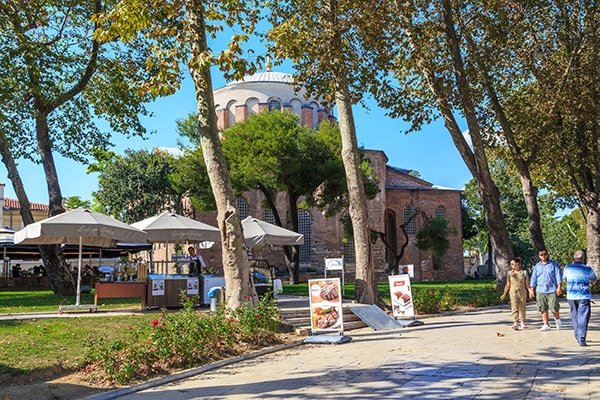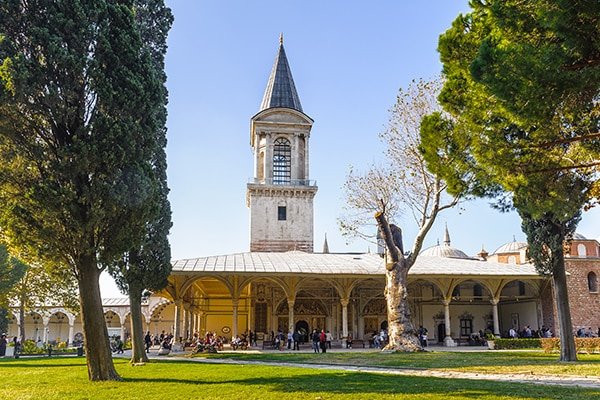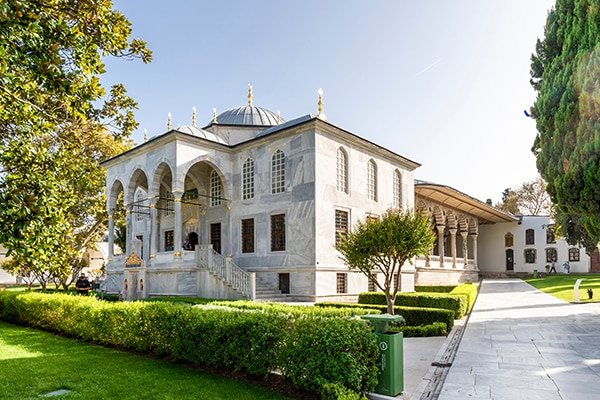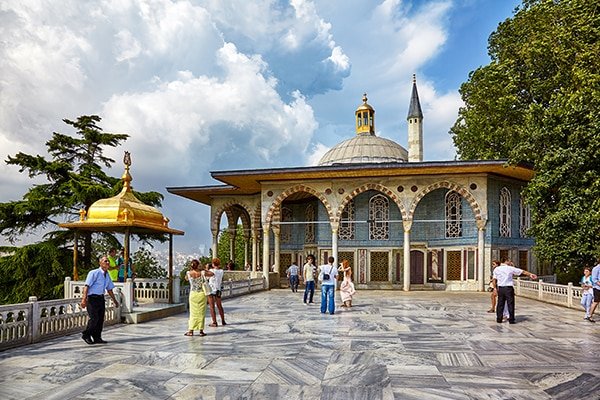Inside
If you want to get a taste of true Ottoman grandeur, a visit to Topkapi Palace is a must. The sprawling complex is full of intricate details. Inside, you'll find lavish courtyards and gardens, delicate mosaics and artworks, opulent decorations and collections, as well as stunning views of the cityscape below.

First Courtyard
The First Courtyard is the only area of the palace that was open to the public during the Ottoman era. Ceremonies and processions took place here. Even today, it is accessible to everyone without a ticket.
To get there, coming from Sultanahmet Square, walk past the beautiful Fountain of Sultan Ahmet III from 1729, and enter through the Imperial Gate, which is the main entrance to Topkapi Palace.
Here, there are several interesting areas and structures worth visiting, including:
The Garden: Upon entering the First Courtyard, you are welcomed by the beautiful palace gardens. It is a wonderful place to take a stroll in a peaceful environment.
Hagia Irene: This 4th-century Byzantine church is the first Christian Orthodox church built in the city, a full 200 years before the famous Hagia Sophia. During the Ottoman period, it served as an arsenal and warehouse. Today it is a museum and, due to the unique acoustics, classical concerts are sometimes held here. Note: To see the inside of the church, you need a separate ticket.
Fountains: There are several fountains on the area, but perhaps the most interesting one stands here and is called the Executioner's Fountain. It owes its name to the alleged ritual where the executioner was said to wash his hands here after an execution.

Second Courtyard
As you pass through the Gate of Salutation, you’ll reach the heart of Topkapi Palace. Here, not only were the state administrative buildings located, but also the famous Harem and several other remarkable structures:
Harem: The Harem was not only about the Sultan's sexual pleasures but, more importantly, about the dynastic reproduction of the ruling family. Several hundred harem ladies served this purpose. The entire complex reflects various architectural styles from the 16th to the early 19th century and holds great significance in architectural history. >> Read more: The Harem of Topkapi Palace
Imperial Council Chamber: In this three-story building on the edge of the second courtyard, the imperial council met four times a week, governing the Ottoman Empire. The room to the right of the chamber showcases the palace's clock collection.
Tower of Justice: The Tower of Justice on the left side is an intriguing structure. What makes it interesting is its connection to the Harem, allowing the Sultan to enter a small room and eavesdrop on the imperial council meetings unnoticed.
Imperial Treasury: In the former imperial treasury, you will be amazed by the vast collection of weapons and armor spanning 1300 years, ranking among the most significant of its kind worldwide. The collection includes weapons specially crafted for the Sultans, as well as arms from Turkish, Arab, Indian, Japanese, and European cultures.
Palace Kitchens: On the right side of the courtyard, you'll find the palace kitchens. These kitchens not only fed the Ottoman royal family but also thousands of palace staff. Today, you can see Ottoman kitchen utensils here, along with an impressively large collection of Chinese porcelain.

Third Courtyard
If you enter the Gate of Felicity, you'll find yourself in the Third Courtyard, which was the Sultan's private residence. Here are some of the attractions you can explore:
Audience Chamber: This 16th century pavilion, with its beautiful facade, was where the Sultan received his viziers, important officials and foreign ambassadors to discuss state affairs. It's interesting to note that inside there are faucets, which were all opened to prevent anyone from eavesdropping.
Sultan Ahmet III Library: This magnificent building from the Ottoman Tulip Era impresses with its opulent interior. Marvel at the artistic tiles and doors adorned with inlays of mother-of-pearl and ivory.
Dormitory of the Expeditionary Force: This 18th century building is home to two chambers that display the palace's rich collection of Sultan's clothing today. You can see imperial robes, uniforms and caftans woven with silver and gold threads.
Sacred Safekeeping Rooms: Some of the most important treasures in the Topkapi Palace are on display in this room, which is decorated with Iznik tiles. These include holy relics of the Prophet Muhammad, such as the hair from his beard, the tooth he lost during the battle of Uhud, and his footprints. Other sacred relics attributed to other prophets are also exhibited, such as the staff of Moses, the sword of David, the tray of Abraham, and the robe of Joseph.
Privy Chamber: The Privy Chamber: This chamber is located next to the storage rooms of the Holy Relics and houses an exhibition featuring 36 portraits of Ottoman Sultans. Additionally, there is a collection of calligraphy and miniatures to admire.
Imperial Treasury: The 15th century Conqueror's Pavilion is a highlight of the palace, with six rooms, a beautiful fountain in the courtyard, and exhibits from the Imperial Treasury. The collections are breathtaking, and include some of the most valuable palace treasures, like precious jewels, heirlooms, and artworks. Be sure not to miss the famous Topkapi Dagger and the 86-carat Spoonmaker's Diamond - the fourth-largest diamond of its kind in the world!
The Piri Reis World Map: In this section, particular attention is given to the world map drawn by the Ottoman admiral Piri Reis in 1513. It was considered lost for many centuries until it was accidentally rediscovered during the inventory of the palace library in 1929. What makes the map remarkable is that it depicts Antarctica without ice, even though the continent was not discovered until 500 years later in 1818. How Piri Reis could have known about the existence of Antarctica and that it was ice-free in the 16th century remains unresolved to this day. The map was added to the UNESCO Memory of the World Register in 2017.

Fourth Courtyard
The Fourth Courtyard is one of the most beautiful places in the palace, filled with lovely pavilions, terraces, and gardens. Highlights include:
Baghdad Pavilion: With a magnificent green and blue Iznik tiled facade, the Baghdad Pavilion is one of the masterpieces of classical Ottoman pavilion architecture. Admire the beautiful interior with colorful tiles, painted ceiling, stained-glass windows, mother-of-pearl and tortoise shell inlay, a fireplace, and a silver grill - a gift from the French King Louis XIV.
Circumcision Chamber: The rectangular room with the impressive facade, adorned with elaborate blue and white tiles is the chamber that was used for the circumcision of the sons of Sultan Ahmed III. With its 16th and 17th century tiles, the interior is equally magnificent.
Iftar Arbor: The small arbor with its tulip-shaped gilded roof and four gilded copper columns was the place where the Sultan used to brake his fast during Ramadan. For Topkapi visitors, it might be the most popular spot for souvenir photos. From here, you have a magnificent view of Istanbul.
Yerevan Kiosk: The Yerevan Kiosk is an octagonal pavilion decorated with Mamluk-style marble slabs. When you step inside, you will be amazed by the richly adorned interior, which features hand-drawn patterns in gold leaf, wooden shutters with mother-of-pearl, and a gilded copper fireplace.
Mecidiye Pavilion: The pavilion is the newest building in the palace, dating back to 1858. Its architecture reflects influences of European styles. From its terrace, you can enjoy the breathtaking view of the Sea of Marmara, the Bosphorus, and Asia.
Chamber of the Chief Physician: This two-story building was once the physician's treatment room, serving the sultan and the royal family. Today, in the basement of the building, it shows an exhibition of pharmaceutical instruments and equipment.
The Garden: During the blooming season, the flower garden between the pavilions shines with beautiful tulips.
Outer Terrace: One of the most stunning viewpoints of Istanbul can be found in Topkapi Palace’s Fourth Courtyard. Head to the lower level terrace and find the Mecidiye Pavilion for a breathtaking view of the Golden Horn and the Sea of Marmara.
